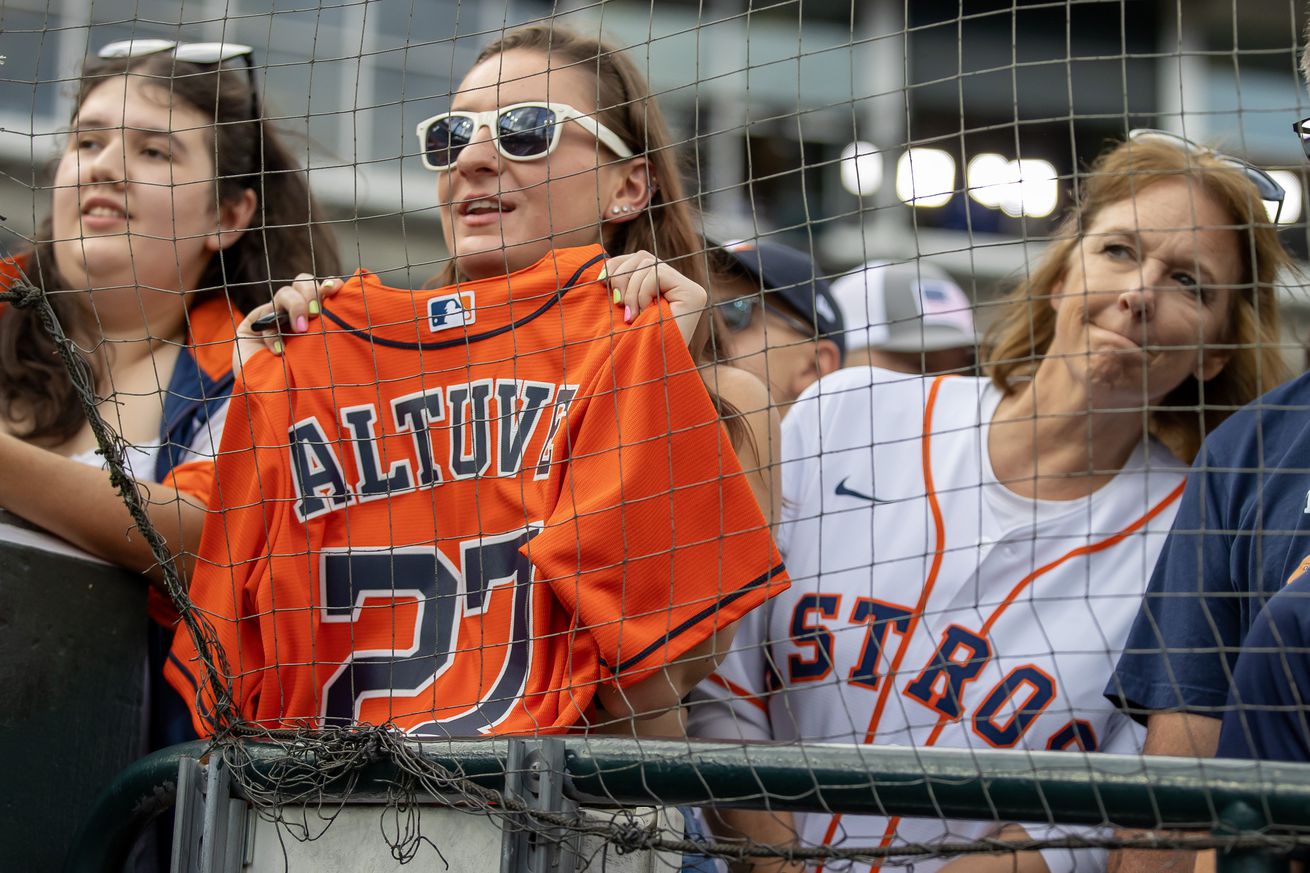
Five Statistical Points Related to the Astros
Let’s talk about five statistical facts related to the Astros. No real rhyme or reason for selecting these items—other than they interest me. But they are pieces to the jig saw puzzle that is the Astros 2023 season. And, oh yes, the “fifth” thing is the update to the current playoff odds. I’ll leave it to your opinion as to whether that is a “fact” or “factoid.”
- What is cWPA and what does it have to do with the biggest plays (so far) in the playoff races?
I think many fans are familiar with Wins Probability Added (WPA). That quantifies how much a particular at bat adds to the probability of winning a game. cWPA (championship win probability added) is the at bat’s contribution to the team’s probability of winning the World Series. Did you know that cWPA is calculated for the plays which have occurred so far in the season? Fangraphs’ Chris Gilligan discusses cWPA (“Looking for Drama?”) and calls it the ultimate descriptive statistic, because cWPA shows how each play contributes to the ultimate goal, winning a championship. Since winning the World Series is dependent on the probability of getting into the playoffs, the cWPA at this stage of the season can tell us a lot about the players who have made critical plays in the playoff races.
The Fangraphs article finds that Kyle Tucker’s 9th inning grand slam against the Orioles’ Felix Bautista is the single biggest cWPA play this month and second highest cWPA play this season. Tucker’s August 8 at bat is at the top of the article’s six best cWPA in August. As shown below, the quality of Tucker’s at bat added drama to the cWPA moment.
Kyle Tucker came out on top in an epic 9-pitch duel with Félix Bautista in the 9th. pic.twitter.com/citBNPmP2v
— MLB (@MLB) August 9, 2023
Five of the six highest cWPA at bats cited by Fangraphs involved the AL West playoff race. Three of the plays involved the Texas Rangers on the road in San Francisco and Arizona. The sixth highest cWPA was Adam Duvall’s 10th inning HR against the Astros last week. I’ll spare you that video.
2. Astros hitters have come up big on cWPA so far this season.
The cWPA is accumulated for each hitter on Baseball-Reference.com. The top cWPA hitters are 1. Kyle Tucker and 2. Chas McCormick. That’s fairly startling. Tucker and McCormick both have higher cWPA than names frequently mentioned in MVP discussions, like Mookie Betts, Corey Seager, Shohei Ohtani and Freddie Freeman. In addition, Alex Bregman is 12th, Yordan Alvarez is 17th, and Jose Altuve is 22nd in cWPA. As of Aug. 28th, almost 20% of the top 22 highest cWPA players (out of over 600 total hitters) are Astros.

Erik Williams-USA TODAY Sports
3. Hunter Brown’s peripheral stats indicate that he has pitched better than his ERA.
Hunter Brown currently has a 4.48 ERA, which probably is below fans’ expectations for this season. However, Brown’s peripheral stats indicate that he has pitched better than his ERA. And that usually is a sign that his ERA could regress in a favorable direction in the future.
His FIP (Fielding Independent Pitching) is 3.87, which is 0.6 runs lower than his ERA. His x-FIP, which normalizes the volatile HR/flyball rate, is 3.33, which is more than 1 run below his ERA. Brown’s expected ERA (x-ERA) is 4.07, which is 0.4 runs lower than his ERA. It’s like flashing lights signaling potential for improved pitching results. Hunter Brown stands alone among Astros’ starting pitchers with these favorable indicators.
4. A macro view of issues causing the Astros’ starting pitching to stumble this season.
The Astros stating pitching has begun to stumble as the team heads toward the finish line. Let’s look at major league rankings. Last year, the Astros were 2d in ERA (2.95). But this year the Astros are 8th in ERA (4.04), and give up the second most barrels (199 so far) in the majors, which compares to the eight fewest barrels (180 over a full season) in 2022. The diminished performance is worse in the 2d half of 2023—-4.75 ERA in the 2d half vs. 3.65 ERA in the first half.
The Stuff+ Pitch Modeling at Fangraphs can provide some insights regarding starting pitchers in the aggregate. Despite the injuries in the rotation, the starting pitchers’ stuff remains well above average. The Astros’ rotation is tied with the Mariners for the 5th best Stuff+ ranking, which measure the physical attributes of the pitches, such as velocity, movement, and spin. But the Astros’ starters are tied with the Angels for 25th (99) in Location+, which measures the departure of pitches from the ideal location, given the pitch count and number of outs. By contrast, in 2022 the Astros were 8th best (102) in Location+. This supports the notion that the diminished performance is due to poor command rather than a decline in pitchers’ stuff.
Digging deeper, the Astros’ rotation is 8th ranked in fastball Stuff+, but the starters’ fastball Location+ is 27th or 3d worst. The relationship is similar for Astros starters’ sinkers: 10th in Stuff+ and 24th in Location+. The Astros’ rotation is very good at throwing the cutter: 1st in Stuff+ and 6th in Location+. The Astros rotation gets into more trouble with the slider: 14th in Stuff+ and 28th in Location+. The Astros starters’ curveballs are very good in terms of Stuff +, with a No. 4 ranking but poor in Location+, with a 27th ranking. Again, this appears to indicate that the issue for most pitches (except the cutter) is location or command, rather than the physical attributes of the pitch. If command has declined, one would expect more control issues and a decline in K-BB%. And, in fact, the K-BB% has declined from 17.3% (ranked 5th) in 2022 to 14.2% (ranked 16th) in 2023.
The Astros’ starters who are superior in Location+ are Verlander and Urquidy. Verlander shows good command of his pitches, with generally above average Location+ (FB 101, Slider 111, Curveball 99, Change 114). Urquidy is above average on Location+ for all of his pitches (FB 101, Sinker 108, Slider 102, Curveball 105, Change 110). The indications of diminished FB performance for Javier are apparent in both Stuff+ (99) and Location+ (98). Javier continues to have good stuff on his slider (Stuff+ 107) but his Location+ for the slider (84) reflects poor command of the pitch.
The Astros’ starting pitchers could improve significantly by honing their command of pitches. But that’s easier said than done.
5. Updating the AL West Playoff Odds
The fifth thing is updating the playoff odds. For the reasons I have explained in the past, I use the Fangraphs playoff model. The most notable observation is the Rangers quick vertical descent in AL West division odds. Ben Clemens at Fangraphs has an article detailing the reasons for the Rangers’ plummet.
The Astros are shown with slightly higher odds of winning the division over the Mariners. But the final projected record is only four-tenths percent higher than the Mariners. The Rangers’ division odds have fallen below 20%. All three teams are likely to make the playoffs, but only the Mariners and Astros have odds above 80%.
(Division Odds / Playoff Odds)
Astros 41.4% / 88.7%
Mariners 40.0% / 86.7%
Rangers 18.6% / 67.6%
The Astros have the easiest remaining schedule (.495), followed by the Mariners (.511), with the Rangers playing one of the hardest remaining schedules (.520) in the American League.